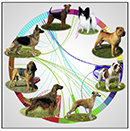"In Brief
The domestic dog is divided into hundreds of island-like populations called breeds. Parker et al. examine 161 breeds and show that they were developed through division and admixture. The analyses define clades, estimate admixture dates, distinguish geographically diverse populations, and help determine the source of shared mutations among diverse populations."
Genomic Analyses Reveal the Influence of Geographic Origin, Migration, and Hybridization on Modern Dog Breed Development

Dog Genes Tell Surprising Tales
Streamed live on Apr 6, 2017...
Dr. Ostrander’s team has taken advantage of naturally occurring variations in dog populations in order to reveal the genetic mechanisms underlying both simple and complex traits. She will show how findings related to the genetic basis for canine disease, behavior, and morphologic traits frame our thinking of human growth regulation, disease, and population migration.
Edited by Ann Milligan
Report Entry
 Donate
Donate
Recommended Comments
There are no comments to display.
Join the conversation
You can post now and register later. If you have an account, sign in now to post with your account.
Note: Your post will require moderator approval before it will be visible.